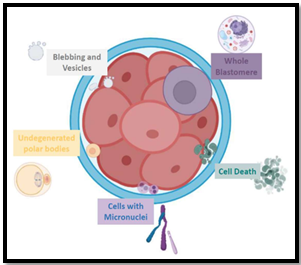MECHANISM OF EARLY CELL ELIMINATION IN HUMAN EMBRYO DEVELOPMENT
Why in the News?
- Researcher Manvendra Singh’s analysis revealed a group of non-committed cells within the ICM.
- Non-committed cells fail to contribute to later embryo stages and are eliminated early.
Source: MDPI
Embryonic Development Overview
- Origin: Single-celled zygote from fusion of paternal and maternal cells.
- Multiplication: Zygote multiplies, initiating embryonic development.
- Cell Differentiation: Cells diversify into various cell types (skin, muscles, nerves).
Unveiling the Role of HERVH and Transposons
- HERVH Presence: Pluripotent stem cells in ICM express HERVH.
- Transposon Activity: Non-committed cells lacking HERVH express transposons, causing DNA damage and cell death.
- Protective Role: HERVH safeguards cells from transposon-induced damage.
Implications and Insights
- HERVH Significance: HERVH contributes to cell survival and potential implications for regenerative medicine.
- Fitness Impact: Healthier embryos likely have more HERVH-expressing ‘good’ cells and fewer non-committed cells.
- Potential Applications: Speculations about infertility treatment and in vitro fertilization based on altering transposon activity.
Placenta’s Role and Consequences
- Transposon Activity: Cells forming the placenta also express transposons but exhibit more tolerance and survive without HERVH protection.
- Cost-Benefit Analysis: The placenta, while different from fetal cells, serves a temporary purpose and is discarded after childbirth.

 Source: MDPI
Source: MDPI

